Freelance Statistics: 40 Facts and Trends You Should Know in 2023

Freelancers are virtually everywhere. There are so many jobs that can be adapted to this business model that the freelance industry has massively expanded. Freelancing seemingly popped out of nowhere and has since become a trillion-dollar industry that everyone is trying to break into.
If you’re part of the up-and-coming Gen Z workforce, chances are good that you’re a freelancer. If you’re not a part of this generation but are still a freelancer and interested in some fun facts, stats, and trends about the freelance industry or how to make money as a freelancer, you’re in the right place.
Interesting Freelance Statistics
- There are 57 million freelancers in the US.
- 59% of responders in the United States were male freelancers.
- 86% of freelancers typically work from home.
- Content writing is one of the most popular freelancer occupations.
- 84% of freelancers say work lets them live the lifestyle they want.
- 64% of freelancers said their health has improved.
- 46% of freelancers choose their job because of their flexibility.
- 41% of freelancers find work through their past clients.
- The US had the most demand for freelancers in 2020.
- The freelance industry makes up almost 5% of the total US GDP.
For this exact purpose, we’re sharing everything there is to know about the freelance industry, and we’ve categorized it into four interesting categories which include 40 stats and facts.
Common freelance statistics
The world of freelance is a vast one. Many people are freelancing every day. The world of freelance is expansive, because it includes a multitude of industries. Ever dynamic, challenging, and growing, freelance is a force to reckon with. In this section, we’ll cover some of the most common statistics about the freelance world, the industry, and the freelancers that operate within it.
1. Number of freelancers vs. monthly visits on the main freelancing websites
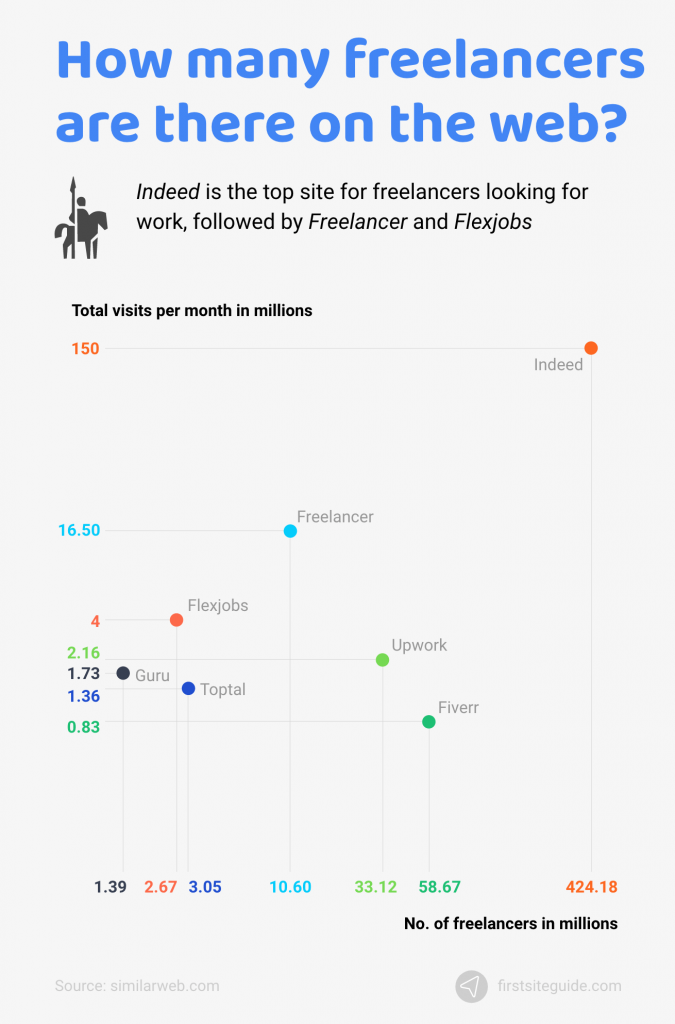
There are several popular freelance jobs websites where freelancers constantly look for jobs. Most popular, Indeed, is able to attract 150 million freelancers to visit their platform. It is followed by Freelancer with more than 16 million freelancers and FlexJobs with around 2 million freelancers looking for jobs on a monthly basis.
(Source: similarweb.com multiple pages)
2. There are currently 57 million freelancers in the US.
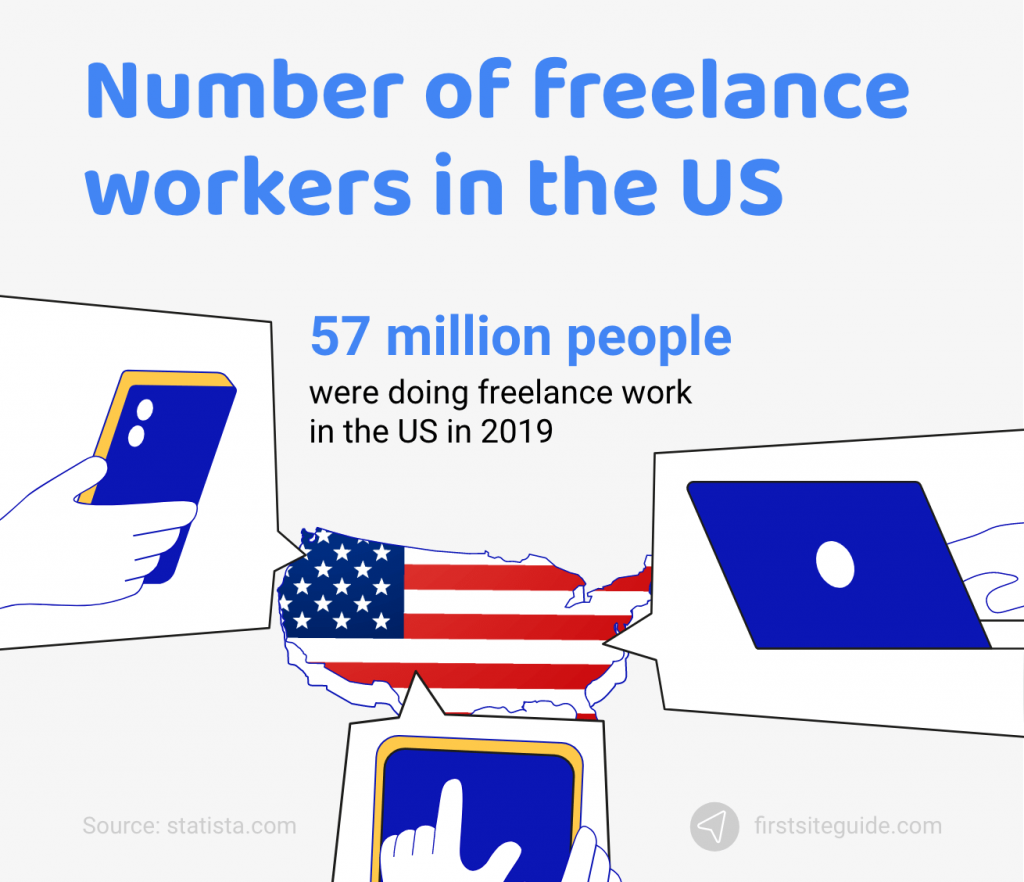
The size of the freelancing population is continually on the rise. From 2014 to 2019, the number of freelancers in the US grew from 52 million to a whopping 57 million. This means that there have been over 5 million new people added to the freelance workforce in just five years which has grown by 8.8%.
(Source: statista.com)
3. 38% of independent workers identify themselves as freelancers.
The number of freelancers is on the rise but only includes what people consider to be freelancers. A whopping 38% of independent workers interviewed consider themselves to be freelancers.
(Source: and.co)
4. 53% of Generation Z workers are freelancers.
The younger the worker, the more likely they are to freelance. However, every generation has more than 1 in 4 workers who freelanced in the past year. The ascent of freelancing is clear in generational survey results: 29% of Baby Boomer workers (ages 55+) freelanced, 31% of Gen X workers freelanced (ages 39-54), 40% of Millennial workers (ages 23-38) freelanced, and 53% of Gen Z workers (ages 18-22) freelanced. This Gen Z survey result is the highest independent workforce participation of any age bracket since FIA’s 2014 launch.
(Source: upwork.com)
5. 59% of responders in the United States were male freelancers.
This study concluded that males make up most of the freelance workforce and the overall number of U.S. workers. Over 59% of freelancers in the U.S. are male, making it an even more male-dominated industry than the traditional workforce, which comprises about 53% of men.
(Source: statista.com)
6. Among 6,001 U.S. freelance workers surveyed, 40% hold a college degree or higher.
This survey concluded that over 40% of the 6,001 freelancers surveyed in the U.S. have a college degree or higher, making freelancers an educated type of workforce.
(Source: statista.com)
7. 86% of freelancers typically work from home.
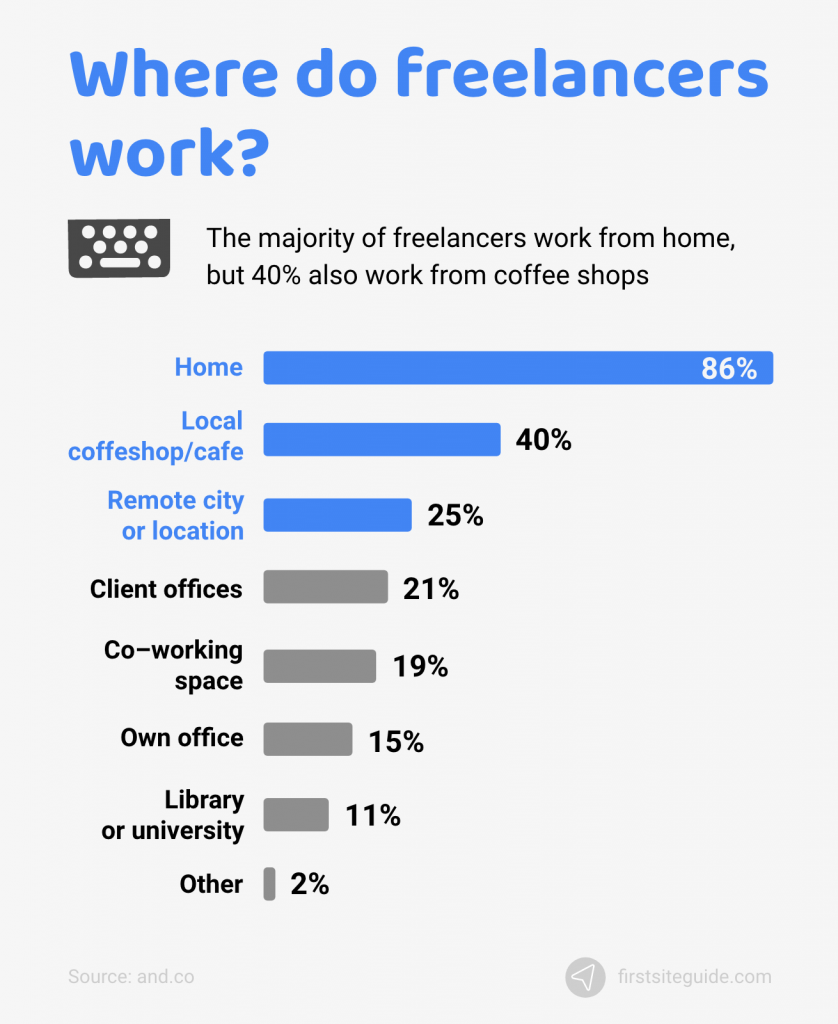
Freelancers usually don’t operate from a corporate office, as a whopping 86% of all freelancers in the U.S. work from home.
(Source: and.co)
8. More than 48% of the women we surveyed fell into the lowest income bracket (34% of men were in this income range).
This survey found that over 48% of all freelancers who identify as women fall into the lowest income range. With men, only 34% fall into the lowest income bracket. This means that men are about 4.5 times more likely to earn $150k per year than women.
(Source: and.co)
9. Freelancing is not one way of working but rather a diverse set of potential activities.
The Sixth annual “Freelancing in America” study concluded that freelancing is far more than a way of working, as it fits the professional needs of many different types of people and circumstances. The most popular type of freelancing involves skilled services such as programming, marketing, and I.T., which makes up about 45% of freelancers.
Unskilled services such as ridesharing, dog walking, and personal tasks make up about 30% of the market share while selling goods and eCommerce make up roughly 26%. Other activities that don’t fall into these categories are very diverse and account for another 29% of the market.
(Source: upwork.com)
10. Most freelancers (61%) specialize across two to three talents.
Freelancers aren’t just one-trick ponies, as above 61% of all freelancers specialize in at least two to three talents and skills.
(Source: and.co)
The economic side of freelancing
Freelancing is a job, and the world of freelance is a very viable industry. It’s an industrial powerhouse worth almost one trillion dollars, and it only seems to be growing in size. To explore the full extent of freelancing and the freelancers that make it all possible, we’ll cover the industry’s economic side by providing some key online business statistics and facts below.
11. Freelance industry makes up almost 5% of the total US GDP.
The freelancing industry is massive, and its GDP sits at approximately one trillion United States Dollars. This means that the freelance industry makes up almost 5% of the total U.S. GDP and has higher revenue than other industries such as construction or transportation. The average skilled services rate is $28 per hour, meaning that skilled freelancers earn more per hour than 70% of the U.S. workforce.
(Source: upwork.com)
12. 30% of Fortune 500 companies use platforms such as Upwork to hire freelancers.
This study found that about 30% of all Fortune 500 companies are using platforms such as Upwork to hire for their freelancer needs. Upwork CEO Stephane Kasriel notes that big companies are getting into using freelancers at a rising rate.
(Source: forbes.com)
13. 41% of information sources for finding work as a freelancer are previous clients.
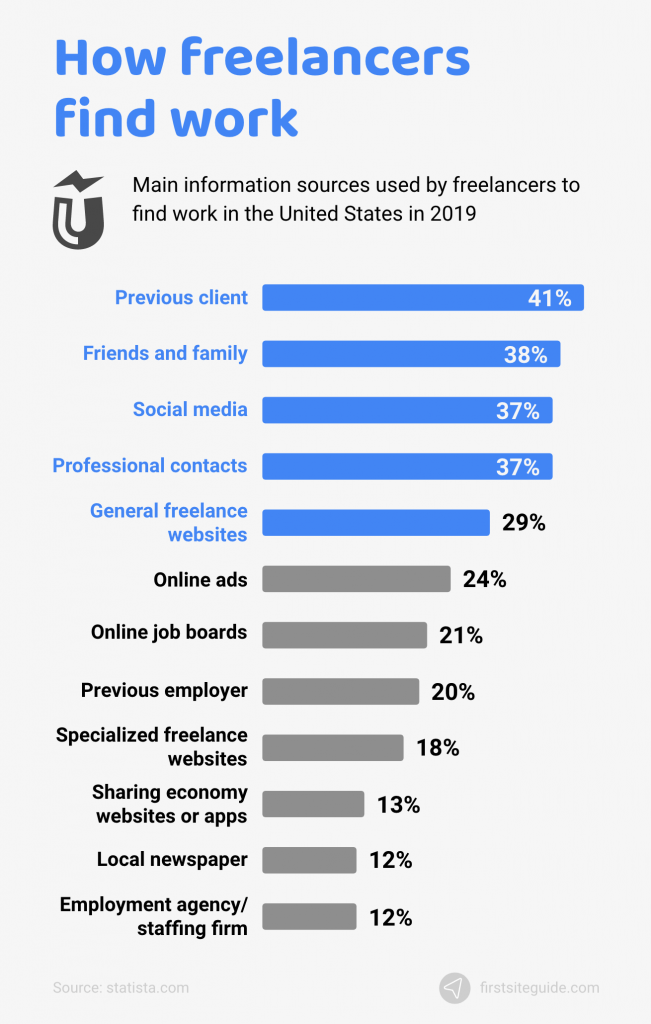
Over 41% of freelancers find work placements through their past clients. About 38% find employment through friends and family, and 37% search for work through social media. Many freelancers use a combination of these tactics to secure as much work as possible.
(Sources: statista.com)
14. Two-thirds of the surveyed freelancers went independent within the last three years.
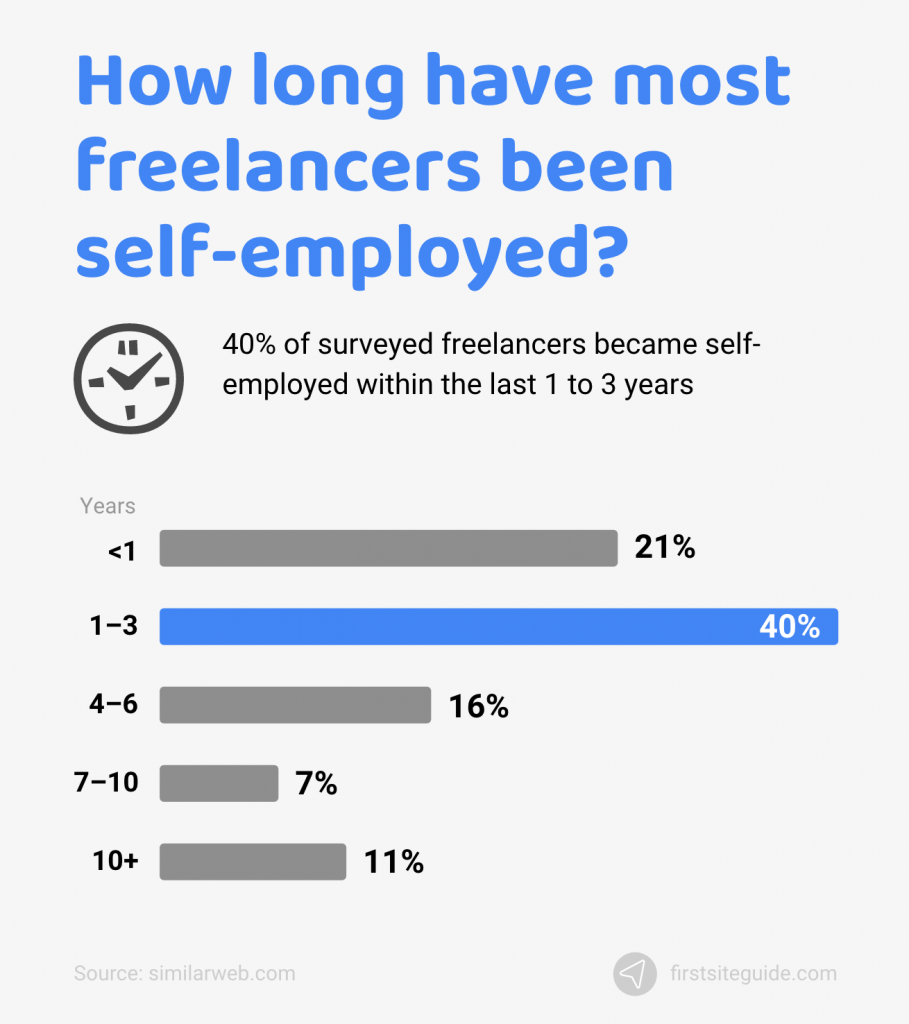
There has been a large influx of new freelancers in the past five years, with over five million new people joining the industry. Two-thirds of the people surveyed stated that they have become freelancers in the past three years.
(Source: and.co)
15. 77% admitted they’re not more financially stable since going independent.
Financial stability is one of the most important things about employment. About 77% of people surveyed concluded that they’re either less financially stable or about the same since they’ve gone independent.
(Source: and.co)
16. 84% of full-time freelancers say their work lets them live the lifestyle they want.
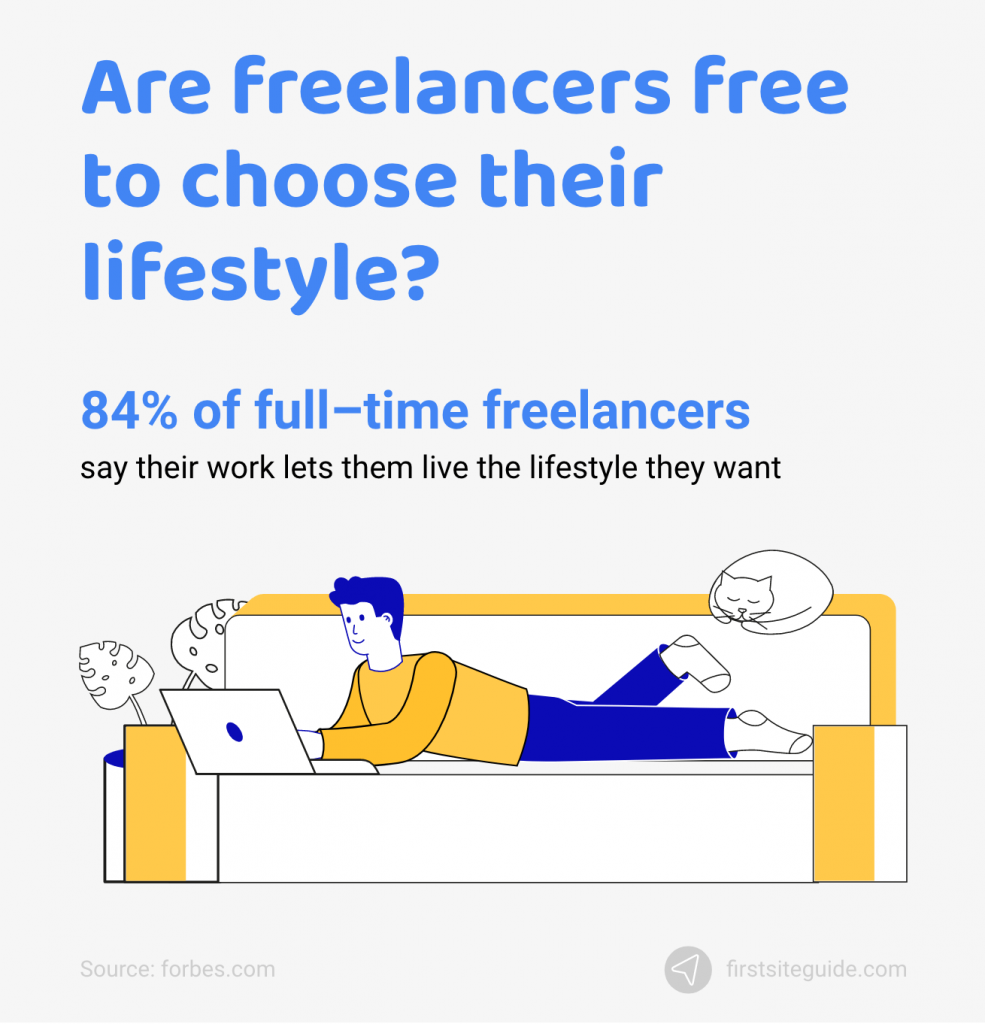
84% of all full-time freelancers report that this work has allowed them to live their lives on their own terms and conduct with any lifestyle they choose. That’s about 21% more people than regular full-time workers.
(Source: forbes.com)
17. 42% of freelancers said they would not be able to do a traditional job due to life circumstances.
42% of freelancers surveyed note that they wouldn’t be able to get a traditional job because of certain lifestyle limitations. That’s because the freelance world is far more flexible than traditional work.
(Source: forbes.com)
18. Freelance content writers make anywhere between $15–$80 per hour on Upwork.
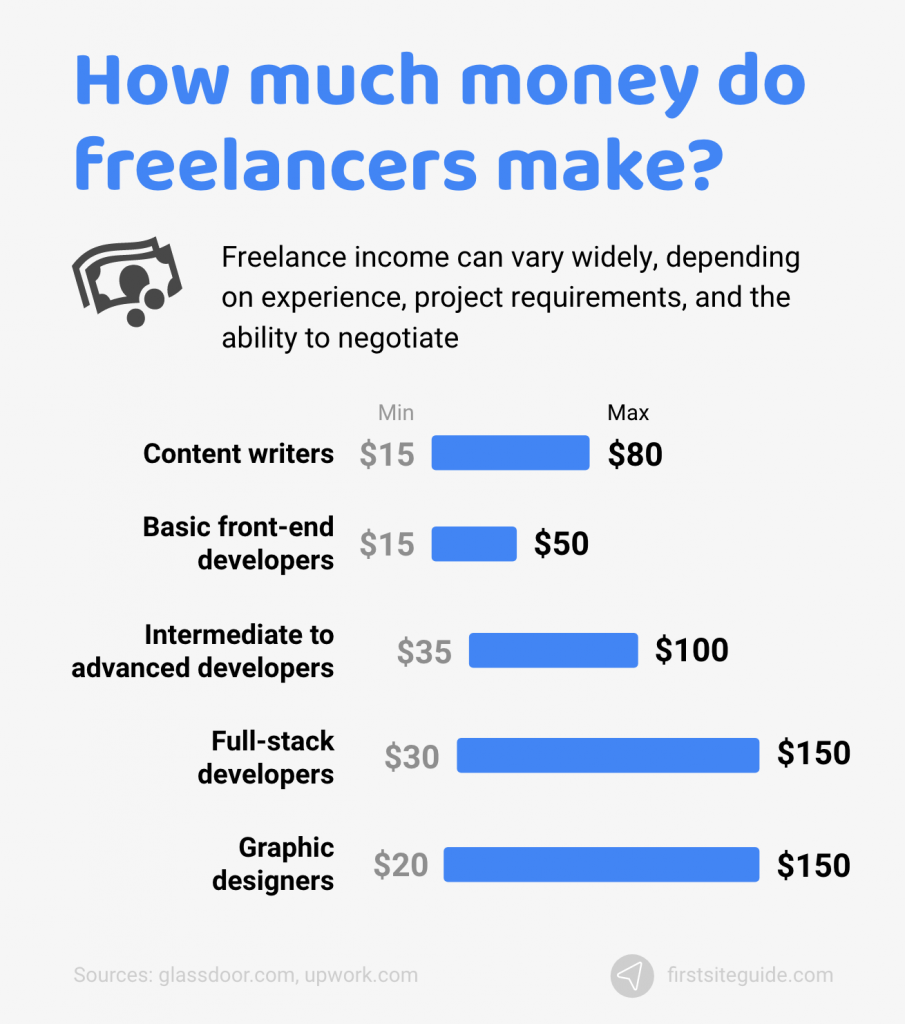
Front-end developers earn $15–$150 per hour on Fiverr.
Content writing is one of the most popular freelancer occupations, and content writers can make anywhere from $15 to $80 per hour on freelance platforms such as Upwork. Front-end coding tasks can bring anywhere from $15 to $50+, while full-stack developers can earn anywhere from $30 to $150+.
(Sources: glassdoor.com, upwork.com, upwork.com)
19. 93% of freelancers with a college degree say skills training is essential for freelancers.
A significant number of freelancers, about 93%, state that skills training is one of the most fundamental things a freelancer must possess. About 70% of full-time freelancers have participated in skills training in the past six months, which is about 21% more than full-time regular workers.
(Source: forbes.com)
20. Among full-time freelancers, 64% said their health has improved since they began freelancing.
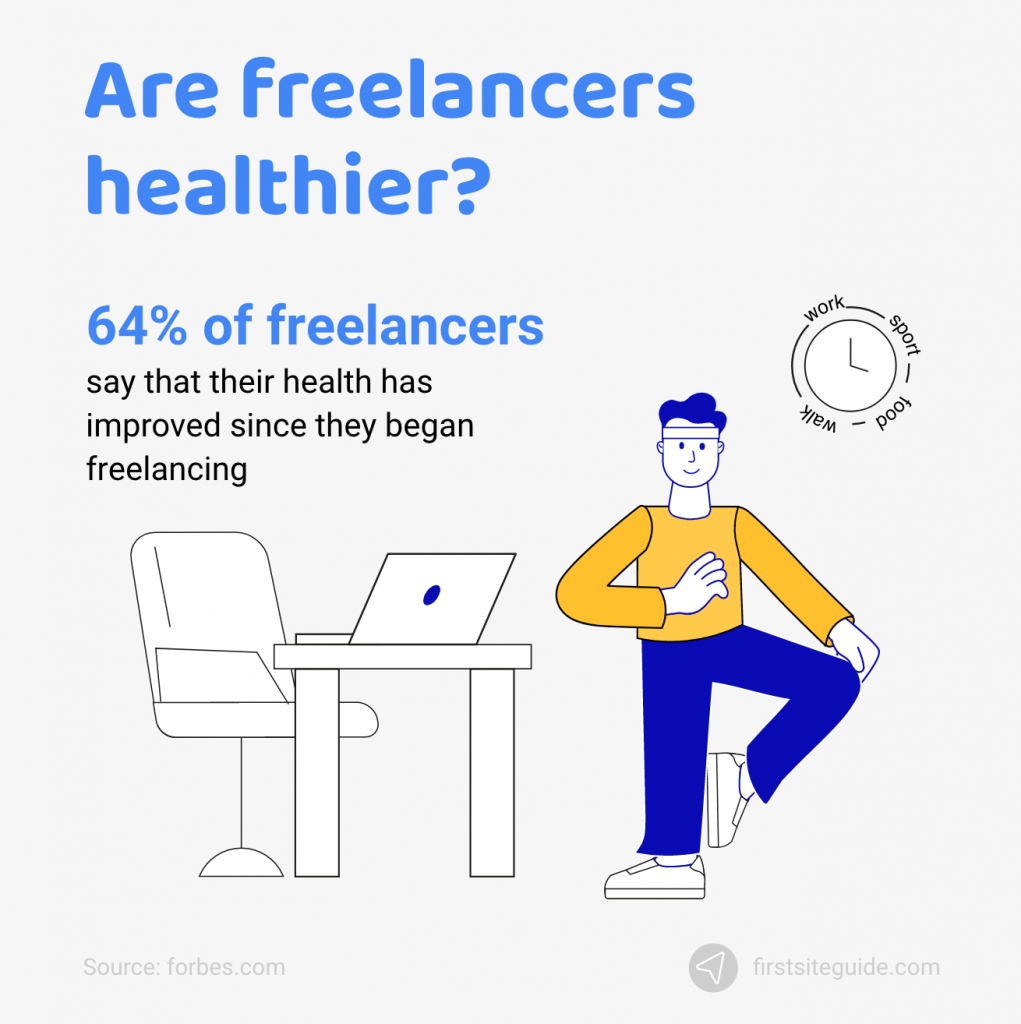
Work can be stressful, and stress can be quite unhealthy. About 64% of all freelancers have stated that their health has improved once they’ve gone independent, which makes freelancing a healthier alternative to traditional work. About 22% of freelancers think that healthcare is a big concern, and about 28% of full-timers purchase a health plan.
(Source: forbes.com)
21. Just 6% of surveyed people said they’re only freelancing until a full-time opportunity comes along.
Many freelancers don’t have any ambitions to leave the independent world behind, with over 94% of all those surveyed stating that they are freelancing for good. Only 4% consider it part-time employment until something full-time comes along.
(Source: and.co)
22. 60% of freelancers surveyed said they’d be interested in pursuing a nomadic lifestyle.
A majority of freelancers say that they’d be open to a nomadic lifestyle where they move locations frequently, about 60%.
(Source: and.co)
23. 7 in 10 freelancers are interested in moving somewhere other than a large city.
About 70% of surveyed freelancers note that they’d be open to moving somewhere outside of a large city, as their job allows them to work from home, which could be virtually anywhere, as long as there is an internet connection.
(Source: upwork.com)
24. The top reason full-time freelancers choose to freelance is schedule flexibility (46%).
Full-time freelancers choose their job because of their flexibility. Flexibility is the top reason why freelancers choose this type of employment, at a whopping 46% of all freelancers, making it their top priority.
(Source: upwork.com)
Coronavirus and freelancing stats
The pandemic has changed many industries. Some have taken quite a severe hit while others have prospered. How has Coronavirus affected the world of freelance work and freelancers themselves? The answer is not bad at all.
Below, we’ll list some interesting statistics about Covid-19 and its effect on freelance work and freelancers themselves.
25. Freelance job openings increased over 25% during the April to June quarter of 2020.
The Freelancers Fast 50 study has established an over 25% increase in job openings from April to June. This study covers the website’s global marketplace, which covers North America, Europe, and Asia.
(Source: cnbc.com)
26. Freelance job postings rose 41% to 605,000 in the second quarter of 2020.
Freelance job postings have risen about 41% to a whopping 605,000 in the second quarter of 2020 compared to the same period in 2019. This is primarily due to the coronavirus pandemic that’s wreaking havoc across the global employment landscape. The growth can also be due to the strong demand for individuals to go solo.
(Source: cnbc.com)
27. Close to 32% of the freelancers surveyed mentioned that demand had decreased greatly.
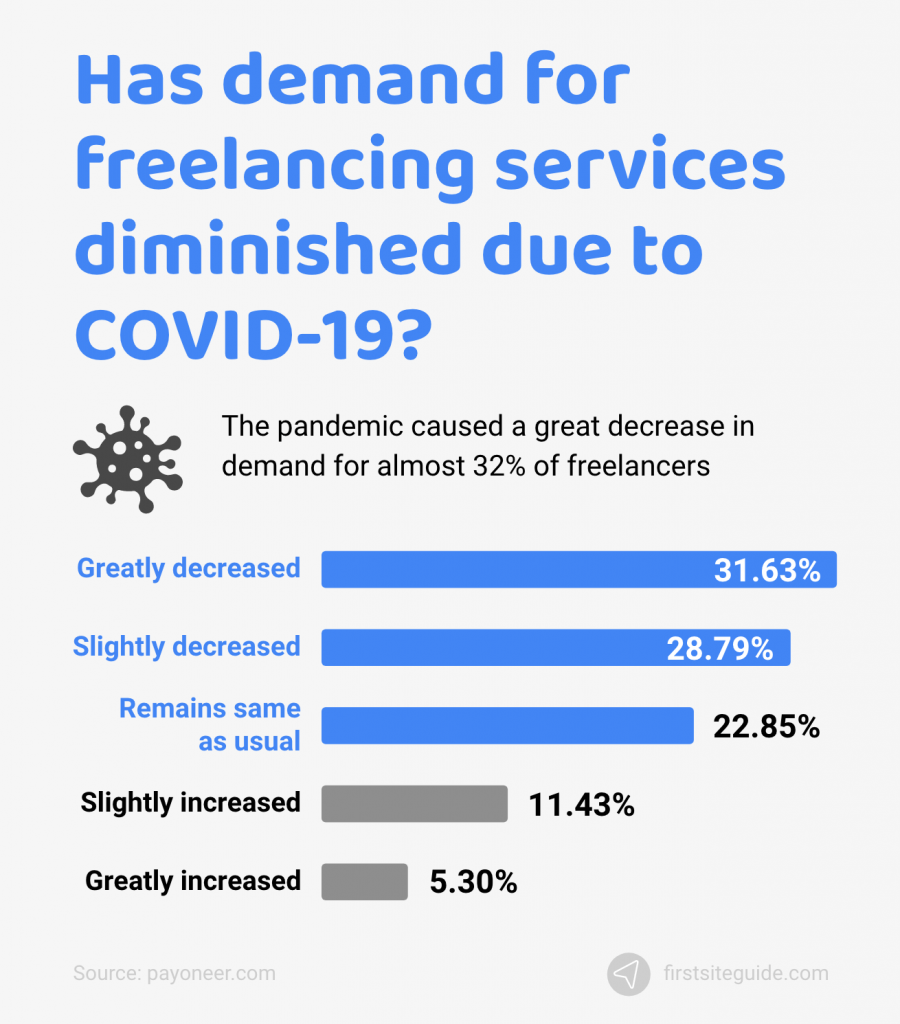
One of the most harrowing statistics about freelance is that almost 32% of all freelancers report that the demand for their services has decreased greatly in the wake of the coronavirus pandemic, leaving many people without steady financial income and employment.
(Source: payoneer.com)
28. Number of working hours lost in the second quarter of 2020 could be the equivalent of 400 million full-time jobs.
The coronavirus has harmed the world of business, as the hours lost during the second quarter of 2020 are equivalent to about 400 million full-time jobs, which is a worrying statistic.
(Source: cnbc.com)
29. Jobs related to mathematical modeling saw the greatest increase (they surged 99.6% to 16,501 jobs) in the second quarter of 2020.
It’s not all doom and gloom, though, as one of the most called for jobs during the second quarter of 2020, as the coronavirus raged, was mathematical modeling. Mathematical modeling has seen a whopping 99.6% increase, which accounts for about 16,501 jobs.
(Source: cnbc.com)
30. In the second quarter of 2020, job postings for eCommerce professionals rose 54.4%.
One of the most common types of employment in the freelance sector is eCommerce. A 54.4% increase in demand was documented via job postings for eCommerce professionals.
Demand for game designers and game developers surged 68% and 64%, respectively.
(Source: cnbc.com)
31. 23% of freelancers reported that business has remained as usual.
A slightly better statistic is that about 23% of people have reported that their business dealings, income, and demand have stayed about the same as before the pandemic, and 17% of freelancers report that the pandemic has increased demand for their services.
(Source: payoneer.com)
32. Close to 74% of survey respondents reported that their rates had remained the same.
About 74% of people in Payoneer’s survey have said that their rates have remained the same during the pandemic, 23% have had to lower their rates to remain a competitor in the market, and about 3% of freelancers have increased their rates.
(Source: payoneer.com)
33. In 2020, the largest share of online labor demand stems from the United States.
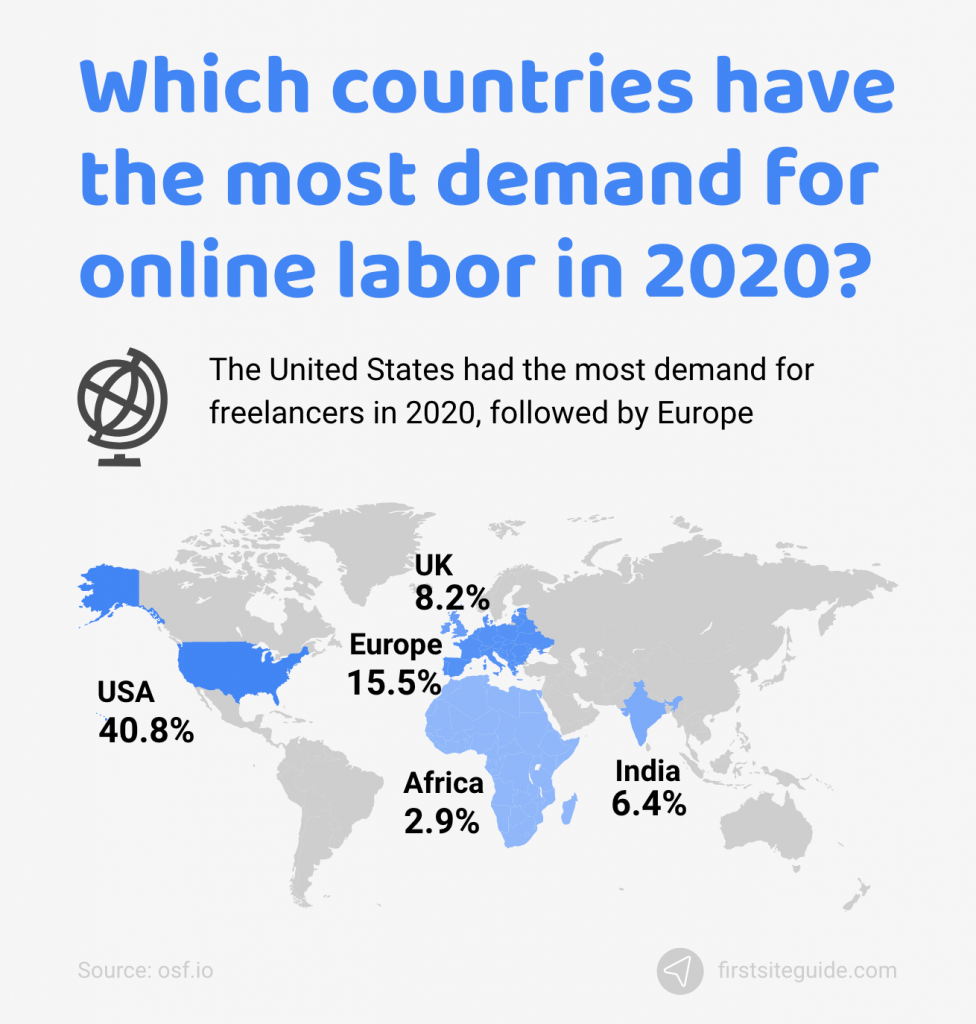
Most of the online labor demand during the global COVID-19 pandemic comes from the United States.
(Source: osf.io)
34. Demand on major online labor platforms from the United States.
U.S. online labor demand has shown a clear seasonal pattern: demand drops during the year-end holiday season and then rises again to reach a plateau in March, which normally persists until June. However, this is not the case for 2020. By mid-March, when the World Health Organization declared COVID-19 to be a global pandemic, online labor demand in the U.S. was in steep decline relative to 2018 and 2019.
(Source: osf.io)
35. Average earnings per week pre and post COVID-19
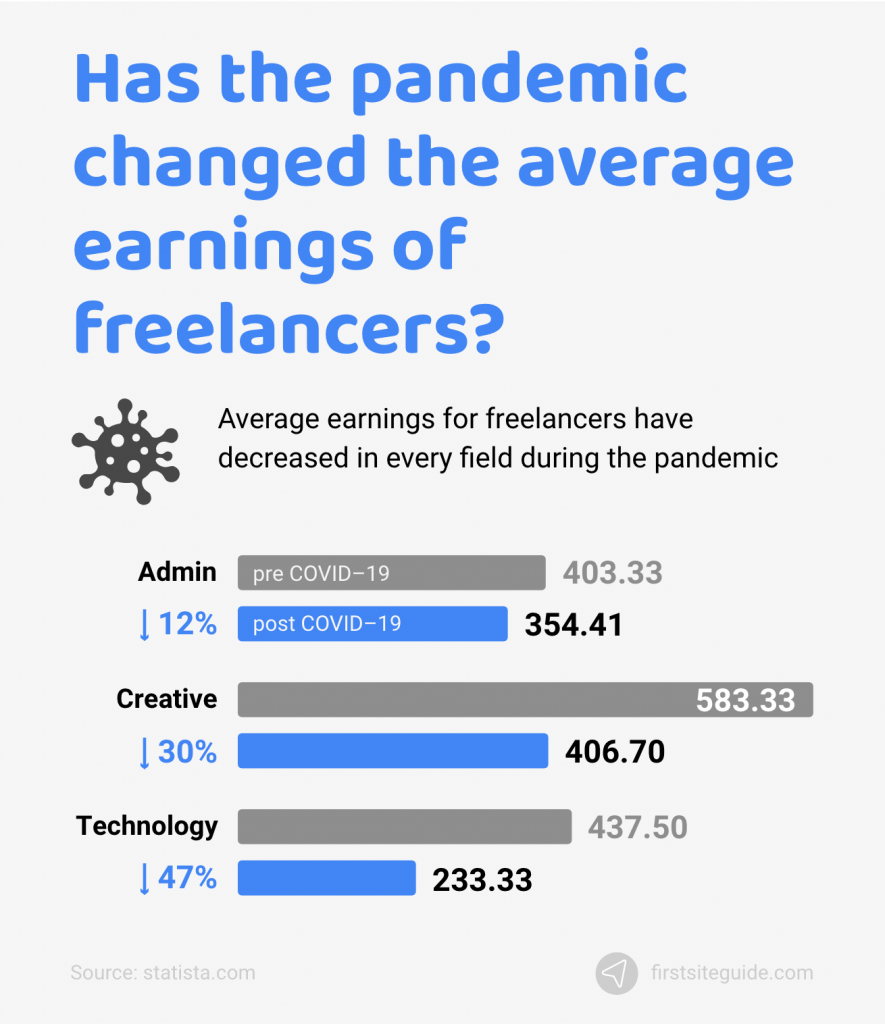
Average earnings have decreased slightly over the course of the pandemic to accommodate for less demand in some sectors and an influx of new freelancers to the industry.
(Source: osf.io)
Random fun stats and facts about the world of freelance
Freelance, while a serious business, it’s not without fun facts. You can find some fun, enjoyment, and entertainment in virtually any industry, and freelancing isn’t an exception to this rule. Below, we’ll list some of the more interesting and fun facts and stats about freelancers and the freelance industry as a whole.
36. 59% of non-freelancers say it is likely that they will do freelance work in the future.
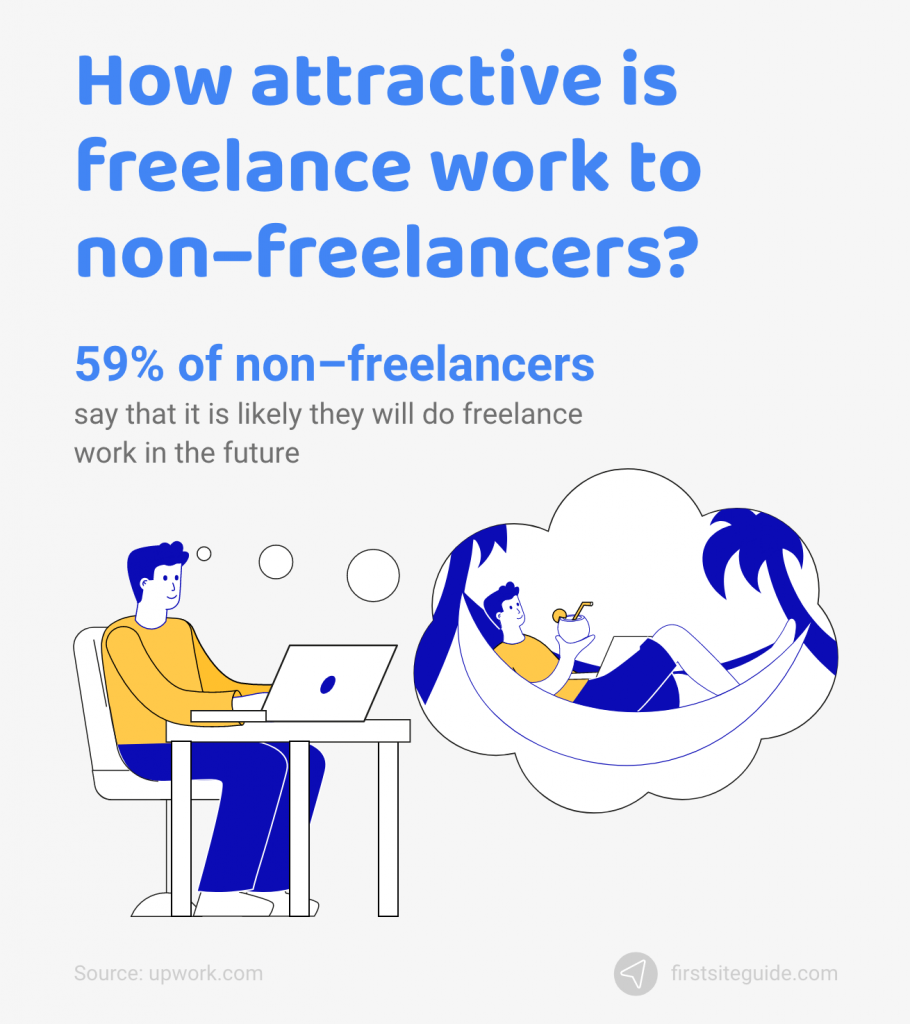
Freelancers love what they do, and they aren’t going to give up on freelancing anytime soon. This study, administered by UpWork, the world’s leading freelance platform, has concluded that about 59% of all non-freelancers are looking to do some freelance work in the future, which might be one reason we’re seeing such an influx of new people into the freelance market.
(Source: upwork.com)
37. 51% of freelancers say that no amount of money would entice them to take a traditional job.
The same study by Upwork has concluded that a slight-above-the-margin majority of freelancers say that there isn’t a sum in the world that would make them consider quitting freelancing and taking on a traditional job.
(Source: upwork.com)
38. 73% say technology has made it easier to find freelance work.
Technology has empowered freelancers ever since the first freelancer freelanced. As technology continues to evolve, freelancers’ work will become simpler. About 73% of all freelancers conclude that finding employment has become far easier than before because of technological advancements.
(Source: upwork.com)
39. 64% say that professionals who are at the top in their industry are increasingly choosing to work independently.
Independence is very important, especially in the professional world. About 64% of people think that professionals at the top of their respective industries are increasingly looking for independent work through freelancing.
(Source: upwork.com)
40. Number of freelancers is growing, but the demand for their services is steady.
The number of freelancers is continually rising, but the demand for their services remains relatively steady.
(Source: upwork.com)
Conclusion
Freelancing is an exciting landscape that shows promise to become one of the most dominant industries in the world. With more and more people flocking to the industry due to the recent global pandemic, its spread to the mainstream is only expedited.
The primary thing we need to look for in the future of freelancing is the incorporation of many more industries into its fold. The most popular things that freelancers do are writing jobs such as grammar and proofreading, web design, marketing, and coding.
As the technology required to do most jobs is slowly moving to the digital landscape, we can expect an influx of new industries into the freelance space, and many new freelancers will hit the market.
We hope that we’ve answered some of your most pressing questions about the world of freelancing and the people who inhabit it with our 40 facts and stats. Make sure to stick with us for more statistic-based content!
